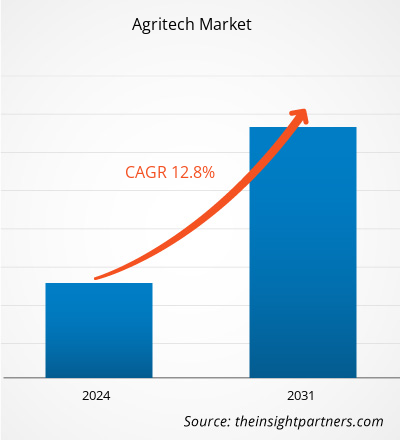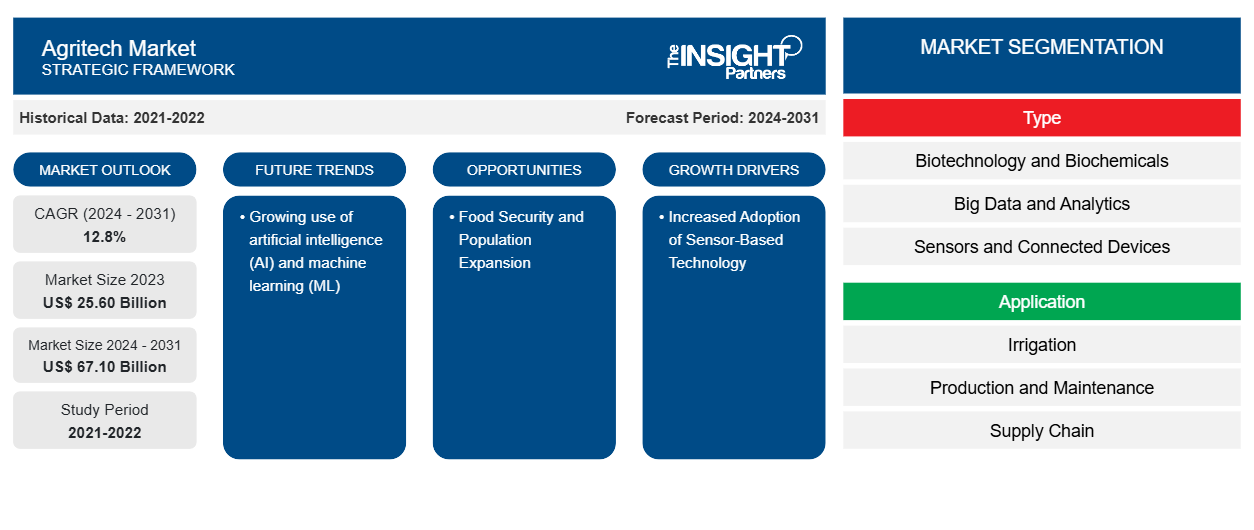全球农业科技市场规模预计将从 2023 年的 256 亿美元增长到 2031 年的 671 亿美元;预计 2024 年至 2031 年的复合年增长率为 12.8%。人工智能 (AI) 和机器学习 (ML) 的使用日益增多,可能仍将是农业科技市场的主要趋势。
农业科技市场分析
基于传感器的农业技术的采用以及农业科技初创企业数量的不断增加是推动农业科技市场增长的主要因素。
农业科技市场概览
农业技术是指在农业领域应用技术突破来提高生产力、效率和盈利能力。这包括利用技术加速种植、培育在各种环境下茁壮成长的作物以及收获。它还可以指利用机器人、大数据、人工智能或任何其他解决农业企业面临的问题所必需的手段。此外,农业技术还用于创建基于物联网的尖端软件,该软件可以跟踪和提供有关天气、土壤质量和当前状态的精确信息。物联网技术用于农业,通过向农民提供有关其作物和农场的实时信息,在不耗尽农民资源或时间的情况下优化农业。
定制此报告以满足您的需求
您可以免费定制任何报告,包括本报告的部分内容、国家级分析、Excel 数据包,以及为初创企业和大学提供优惠和折扣
- 获取此报告的关键市场趋势。这个免费样品将包括数据分析,从市场趋势到估计和预测。
农业科技市场驱动因素和机遇
传感器技术的应用增加,利好市场
基于传感器的技术使用率的提高推动了农业技术行业的技术支出。这涉及传感设备和物联网(IoT) 技术的利用。这些技术使农民能够收集各种参数的数据,包括天气模式、土壤条件和作物产量,从而使他们能够做出更明智的决策。田地中安装的传感器为农民提供有关土壤湿度、温度和酸度的实时信息。这些信息使农民能够及时做出有关灌溉、氮肥输送和作物保护的决策。
粮食安全与人口增长
人口增长给世界粮食供应网络带来压力。农业技术试图满足不断增长的人口的营养需求。无人机和 GPS 导航拖拉机等技术实现了精准种植和收获,从而降低了投入成本和环境影响。此外,数据驱动的解决方案为农民提供了有关天气模式、土壤条件和作物产量的宝贵见解,使他们能够做出明智的决策。
农业科技市场报告细分分析
有助于得出农业科技市场分析的关键部分是类型和应用。
- 根据类型,市场分为生物技术和生物化学品、大数据和分析、传感器和连接设备、移动性等。生物技术和生物化学品部门在 2023 年占据了更大的市场份额。
- 在应用方面,市场分为灌溉、生产和维护、供应链和市场。生产和维护部门在 2023 年占据了更大的市场份额。
按地区划分的农业科技市场份额分析
农业科技市场报告的地理范围主要分为五个地区:北美、亚太地区、欧洲、中东和非洲以及南美/南美和中美。2023 年,北美主导了农业科技市场。区域市场的增长可以归因于精准农业的日益普及。精准农业技术,如无人机、基于传感器的系统和 GPS 引导拖拉机,已在北美得到广泛采用。这项技术使农民能够最大限度地提高作物产量、降低投入成本并提高整体农场生产力。精准农业技术,包括无人机、基于传感器的系统和 GPS 引导拖拉机,已经彻底改变了农业行业。通过利用这些技术,农民可以在其运营中实现更高的效率和生产力。
农业科技市场区域洞察
Insight Partners 的分析师详细解释了预测期内影响农业科技市场的区域趋势和因素。本节还讨论了北美、欧洲、亚太地区、中东和非洲以及南美和中美洲的农业科技市场细分和地理位置。

- 获取农业科技市场的区域特定数据
农业科技市场报告范围
| 报告属性 | 细节 |
|---|---|
| 2023 年的市场规模 | 256亿美元 |
| 2031 年市场规模 | 671亿美元 |
| 全球复合年增长率(2024 - 2031) | 12.8% |
| 史料 | 2021-2022 |
| 预测期 | 2024-2031 |
| 涵盖的领域 | 按类型
|
| 覆盖地区和国家 | 北美
|
| 市场领导者和主要公司简介 |
|
市场参与者密度:了解其对商业动态的影响
农业科技市场正在快速增长,这得益于终端用户需求的不断增长,这些需求源于消费者偏好的不断变化、技术进步以及对产品优势的认识不断提高等因素。随着需求的增加,企业正在扩大其产品范围,进行创新以满足消费者的需求,并利用新兴趋势,从而进一步推动市场增长。
市场参与者密度是指在特定市场或行业内运营的企业或公司的分布情况。它表明相对于给定市场空间的规模或总市场价值,有多少竞争对手(市场参与者)存在于该市场空间中。
在农业科技市场运营的主要公司有:
- ARSR 技术
- 航空农场
- 阿波罗农业
- Crofarm 农产品私人有限公司
- 康瑟维斯
- 靛蓝农业公司
免责声明:上面列出的公司没有按照任何特定顺序排列。

- 获取农业科技市场顶级关键参与者概览
农业技术市场新闻和最新发展
通过收集一手和二手研究后的定性和定量数据来评估农业科技市场,其中包括重要的公司出版物、协会数据和数据库。以下是市场发展情况的列表:
- 2024 年 1 月,帮助小规模农民实现利润最大化的商业农业平台 Apollo Agriculture 获得了 1000 万美元的资金,以支持其持续增长。这家肯尼亚初创公司成立于 2019 年,为农民提供融资、优质农业投入、保险和优化建议,以提高他们的盈利能力。最近的资金将使 Apollo Agriculture 能够扩大其在肯尼亚的业务,帮助更多农民繁荣发展、适应气候变化并为粮食安全做出贡献。
(来源:阿波罗农业,新闻稿,2024 年)
- 2023 年 2 月,获得 B 认证的公司和室内垂直农业领域的全球领导者 AeroFarms 推出了其最新的先进室内垂直农场 AeroFarms AgX。这家尖端设施专注于创新研发 (R&D),位于阿联酋,具体位于阿布扎比。AeroFarms AgX 旨在推进可持续受控环境农业 (CEA) 和室内垂直农业,以应对更广泛的全球农业供应链挑战。
(来源:AeroFarms,新闻稿,2023 年)
农业科技市场报告覆盖范围和交付成果
“农业科技市场规模和预测(2021-2031 年)”报告对以下领域进行了详细的市场分析:
- 范围内所有主要细分市场的全球、区域和国家层面的市场规模和预测
- 市场动态,如驱动因素、限制因素和关键机遇
- 未来的主要趋势
- 详细的 PEST/波特五力分析和 SWOT 分析
- 全球和区域市场分析涵盖关键市场趋势、主要参与者、法规和最新市场发展
- 行业格局和竞争分析,涵盖市场集中度、热点图分析、知名参与者和最新发展
- 详细的公司简介
- 历史分析(2 年)、基准年、预测(7 年)及复合年增长率
- PEST和SWOT分析
- 市场规模、价值/数量 - 全球、区域、国家
- 行业和竞争格局
- Excel 数据集
近期报告
客户评价
购买理由
- 明智的决策
- 了解市场动态
- 竞争分析
- 客户洞察
- 市场预测
- 风险规避
- 战略规划
- 投资论证
- 识别新兴市场
- 优化营销策略
- 提升运营效率
- 顺应监管趋势





















 获取免费样品 - 农业科技市场
获取免费样品 - 农业科技市场